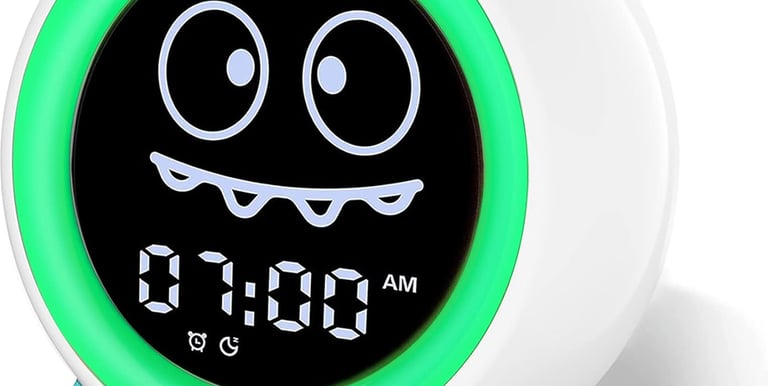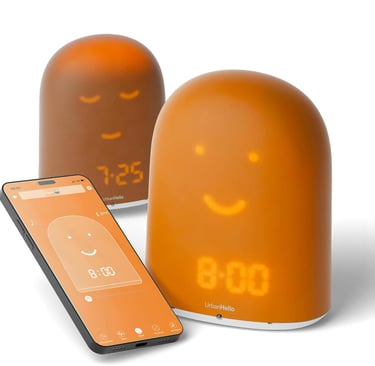Enhancing Sleep Hygiene: Exploring Sleep Technology and Addressing Sleep Disorders
KIDSPARENTINGBABYINFANTS
9/5/20247 min read


Introduction to Sleep Hygiene
Sleep hygiene refers to the collection of practices and habits that are necessary to have a good night's sleep and full daytime alertness. It is crucial for both children and parents to maintain proper sleep hygiene in order to support their physical and mental health. Proper sleep is foundational; it directly impacts our cognitive function, emotional stability, and overall well-being.
For children, consistent and restorative sleep is essential for development, learning, and growth. Poor sleep can lead to issues such as decreased attention, learning difficulties, mood swings, and behavioral problems. Adults, including parents, also suffer the repercussions of insufficient sleep, which include reduced productivity, mental health issues such as depression and anxiety, and an increased risk of chronic conditions like obesity, diabetes, and heart disease.
This blog post aims to explore two pivotal aspects of enhancing sleep hygiene: the role of sleep technology and strategies for managing sleep disorders. Sleep technology encompasses a range of tools and devices designed to promote better sleep and to monitor sleep patterns. This segment of our discussion will delve into innovative solutions available in the market today. Managing sleep disorders, on the other hand, involves understanding various sleep-related issues and adopting evidence-based strategies to mitigate their impact on sleep quality.
The following sections will provide insights and practical guidance on how modern technology can assist in improving sleep hygiene, and how to address common sleep disorders effectively. By understanding and implementing these approaches, individuals can significantly enhance their sleep quality, ultimately contributing to better overall health and well-being.
The Role of Sleep-Tracking Technology
In recent years, sleep-tracking technology has revolutionized the way individuals monitor and enhance their sleep hygiene. These tools come in multiple forms, including wearable devices like smartwatches and fitness trackers, mobile applications, and advanced smart mattresses. Each of these technologies leverages different methodologies to provide comprehensive insights into one's sleep patterns.
Wearable devices, such as Fitbit and Apple Watch, utilize a combination of accelerometers and heart rate monitors to gauge movements and heart rate variability, enabling accurate assessments of sleep duration, stages, and disturbances. On the other hand, mobile applications, which often rely on sensors within smartphones, track sleep based on movement and ambient noise levels. Apps like Sleep Cycle and Pillow not only monitor sleep patterns but also provide features such as smart alarms, which wake users during the lightest phase of sleep for a more refreshed morning experience.
Smart mattresses and mattress covers, such as those from companies like Sleep Number and Eight Sleep, utilize embedded sensors to capture extensive data, including heart rate, breathing rate, and temperature variations. These advanced sleep surfaces offer a holistic view of sleep by recording disruptions and generating personalized recommendations to improve sleep quality.
The data collected by these technologies typically include metrics such as total sleep duration, sleep efficiency, the time spent in different sleep stages (light sleep, deep sleep, and REM), and occurrences of disturbances such as sleep apnea or frequent waking. By analyzing this data, users can identify patterns and potential issues affecting their sleep quality.
The benefits of deploying sleep-tracking technology are multifaceted. Firstly, these tools provide users with a detailed and objective understanding of their sleep patterns, which can be difficult to perceive subjectively. Secondly, recognizing and addressing irregularities can lead to targeted lifestyle changes or medical consultations, ultimately enhancing overall well-being. Additionally, ongoing monitoring can help track the effectiveness of interventions, ensuring sustained improvements in sleep hygiene.
In essence, integrating sleep-tracking technology into one's routine offers an accessible and data-driven approach to mastering the intricacies of sleep, fostering healthier and more restorative nightly rest.
Benefits of Sleep-Tracking for Families
Sleep-tracking technology offers significant advantages for families, promoting healthier sleep patterns for both children and parents. These devices can play a crucial role in establishing better sleep routines, enhancing overall sleep quality, and identifying potential sleep issues early on.
One of the key benefits of sleep-tracking technology is its ability to monitor and analyze sleep patterns. Devices such as wearable trackers and smart mattresses provide valuable insights into sleep duration, sleep cycles, and disturbances throughout the night. By understanding these patterns, families can make informed adjustments to their routines, ensuring that each family member receives adequate rest.
For children, consistent sleep schedules are essential for their growth and development. Sleep-tracking devices can help parents monitor their children's sleep habits and identify any irregularities. For example, if a child consistently wakes up during the night, parents can investigate potential causes, such as sleep environment or daily activities. Armed with this knowledge, they can take steps to create a more conducive sleeping environment or adjust bedtime routines.
Parents can also benefit tremendously from sleep-tracking technology. It enables them to identify factors contributing to their own sleep disturbances, such as stress or external noise. By addressing these issues, parents can improve their sleep quality and better manage their overall health and well-being.
Numerous families have shared testimonials about the positive impact of sleep-tracking technology. One family reported that using a smart mattress helped their child overcome frequent nighttime awakenings, leading to more restful nights for everyone. Another family highlighted how a wearable sleep tracker revealed that their teenager struggled with insufficient deep sleep, prompting a change in bedtime habits and resulting in improved academic performance and mood.
In conclusion, sleep-tracking technology offers a valuable tool for families aiming to optimize their sleep hygiene. By providing detailed insights into sleep patterns and identifying potential issues early, these devices can contribute to healthier, more restful nights for both children and parents alike.
Potential Drawbacks and Limitations of Sleep-Tracking Technology
While sleep-tracking technology offers numerous benefits, it is essential to recognize its potential drawbacks and limitations. One primary concern is data accuracy. Sleep trackers, whether worn on the wrist or integrated into mattresses, utilize various sensors and algorithms to monitor sleep patterns. However, these devices are not always precise. Factors such as the wearer's movement, device calibration, or even ambient environmental conditions can lead to inaccurate readings. Consequently, users might receive misleading information about their sleep quality and quantity, which could lead to counterproductive adjustments to their sleep routines.
Another significant issue is privacy. Sleep trackers collect a wealth of personal data, including heart rate, sleep stages, and movements throughout the night. This information is often stored in cloud servers and can potentially be accessed by third parties. Privacy concerns arise when companies mismanage data or fail to adhere to stringent security protocols, making users vulnerable to data breaches. Additionally, there are instances where data might be used for targeted advertising or sold to third parties without explicit user consent.
Moreover, an over-reliance on sleep-tracking technology can induce anxiety about sleep. Users who become overly fixated on daily metrics might experience increased stress, especially when their sleep data indicates poor sleep quality. This anxiety can create a self-fulfilling cycle, where worry about not getting enough rest leads to actual sleep disturbances. Sleep health education and a balanced approach in interpreting sleep data are crucial in mitigating these stressors.
A balanced perspective is essential for understanding that while sleep-tracking technology provides valuable insights, it is not infallible. Recognizing the technology's limitations and addressing potential pitfalls can help users make more informed decisions and maintain a healthier relationship with their sleep. Fostering an understanding that these tools should complement, rather than dominate, our approach to sleep hygiene is fundamental to maximizing their benefits while minimizing their downsides.
Understanding Common Childhood Sleep Disorders
Sleep is a critical component of child development, influencing both physical growth and cognitive function. However, various sleep disorders can disrupt this essential process. Among the most prevalent childhood sleep disorders are insomnia, sleep apnea, night terrors, and restless leg syndrome. Each of these conditions presents unique challenges and has been the focus of numerous scientific studies.
Insomnia, characterized by difficulty falling or staying asleep, affects approximately 1 in 4 children at some point. Recent research indicates that childhood insomnia can manifest in emotional distress, impaired academic performance, and mood disorders. Conversely, sleep apnea, identified by interrupted breathing during sleep, is present in about 1-4% of children. Studies have shown that sleep apnea is often associated with attention-deficit hyperactivity disorder (ADHD) and necessitates timely medical intervention to prevent long-term cognitive and behavioral issues.
Night terrors, intensely disturbing episodes where the child appears awake but is inconsolable, impact around 1-6% of children, according to recent data. Unlike nightmares, night terrors typically occur during the first half of the night and are notoriously difficult to manage without professional guidance. Restless leg syndrome (RLS), another common issue, involves an uncontrollable urge to move the legs, often seen in 2-4% of pediatric patients. This condition significantly hinders the child's ability to fall asleep and sustain restful sleep, thereby impinging on their overall well-being.
The importance of professional diagnosis and intervention cannot be overstated when managing childhood sleep disorders. Professional assessment involves a comprehensive evaluation, often encompassing sleep studies and psychological assessments to pinpoint the underlying causes. Early diagnosis and appropriate treatment can substantially mitigate the negative impacts on a child's health. Behavioral therapies, medication, and lifestyle changes are commonly prescribed interventions that yield promising results. In summary, recognizing and addressing these sleep disorders via professional channels is paramount for promoting healthy development and ensuring a foundation for lifelong well-being.
Tips for Managing Childhood Sleep Disorders
Managing childhood sleep disorders requires a structured approach that encompasses consistent habits and informed strategies. First and foremost, maintaining a consistent sleep schedule is paramount. Children thrive on routine, and setting a regular bedtime and wake-up time, even on weekends, helps regulate their internal clock. It is beneficial to establish calming pre-sleep activities, such as reading a book or gentle stretching, to signal that bedtime is approaching.
Creating a sleep-conducive environment is another crucial aspect. The bedroom should be a sanctuary for rest, free from distractions such as electronic devices. Dim lighting, a comfortable mattress, and a quiet atmosphere contribute significantly to quality sleep. Monitoring room temperature to ensure it is neither too hot nor too cold can also enhance comfort.
For persistent sleep issues, it is imperative to seek professional help. Consulting with a pediatrician or sleep specialist can provide valuable insights and tailored interventions. Sometimes, underlying medical conditions like sleep apnea or anxiety disorders may be contributing factors, necessitating a comprehensive evaluation. Behavioral sleep interventions, guided by professionals, often yield positive results.
Collaboration between healthcare providers and families is essential for addressing childhood sleep disorders effectively. Open communication ensures that all parties are informed about the child’s progress and any emerging concerns. Parents should feel empowered to share observations and ask questions to better understand the treatment plan and its objectives.
Implementing these strategies requires patience and consistency, but the benefits of improved sleep on a child’s overall well-being are profound. By fostering healthy sleep habits early, parents can contribute significantly to their child’s physical health, emotional stability, and cognitive development. Effective management of childhood sleep disorders not only enhances the child’s quality of life but also fosters a harmonious family dynamic.
Parenting
Empowering parents with essential child-rearing insights.
Support
Resources
contact@yipbeelife.com
© Yipbee Life 2024. All rights reserved.




